Restaurant Michel & Sébastien Bras
Posted on Wednesday, 29th April 2009

Creamed egg with chive oil & views over Laguiole
I once swore that I would never go back to Rodez.
It happened in July 2006 when I was due to fly to Toulon in Provence on Ryanair. Missing my flight by the skin of my teeth, I weighed up all my various options, these being to change my flight to an alternative destination, or to come back the following day for the next flight to Toulon. Faced with the daunting prospect of having to travel out to Stansted Airport again, I decided that an element of adventure and daring was called for. And so I decided to fly to an unheard of destination in Southern France, somewhere I thought would be close to Toulon, and make my way overland instead.
Well that particular destination was Rodez. Standing at the Ryanair customer services counter and peering into the destinations map, the distance between Rodez and Toulon did not appear so far. But as I was to find out soon enough, maps on walls can be rather deceptive.
The distance between Rodez and Toulon is 403 km, something which I found out only after the event. It is perhaps a manageable distance by car. But Rodez is a smallish town, and as I was making this trip by public transport, you can imagine the potential logistical issues that this journey presented. First, to demonstrate how small the town is, only four taxis operated in Rodez at the time. I know this because I waited over an hour for one of them at the airport, and the only reason I managed to make it to my hotel room was because the kindly lady at the tourism office eventually took pity on me and offered me a lift. Second, to demonstrate how logistically problematic, I also soon learnt that to get to Toulon, you must first travel by bus to Montpellier, followed by a train to Marseille, and then by another train to Toulon.
I therefore decided to skip going to Toulon altogether, and to head to Marseille instead where I was to meet a friend two days later. Setting off the next day, what should have been a 3 hour bus ride to Montpellier turned out to be 4 ½ hours. And where I had initially thought a half hour connection time at Montpellier train station would have been sufficient time to purchase a train ticket to Marseille, it soon became abundantly clear that I was wrong. The queues were horrendous, and the service at the ticket desk was extremely slow. Therefore I was faced with a conundrum. To stand any chance of making the train I would have to fare evade. Otherwise, I would have to undergo a dreaded 2 hour wait at the not-so-pleasant Montpellier train station for the next train.
Well, the honest part of my soul won out, although it was doubtful anyone would have checked my ticket anyway. As fate would have it, the next train was delayed, and 2 hours slowly turned into 3. And when the train finally arrived, I was awarded (or punished depending on your viewpoint) with a crowded and badly air conditioned train. Suffice to say when I finally arrived in Marseille at about 6pm, some 32 hours after I had left home, I was not in a happy mood. And when all was said and done and I had added up the cost of my little adventure – the change fare for my flight and my bus and train tickets – I realised I could have purchased another flight ticket to Marseille altogether for less money, and co-incidentally, arrived the night before.
Thus I swore I would NEVER, ever, go back to Rodez again.
And so, such is the irony of life that when you are faced with the prospect of a reservation at the three starred Michelin restaurant Bras, ranked seventh best restaurant in the world (Michel Bras was not at this year’s 50 Best Restaurants Awards), the closest airport just happens to be Rodez. Sigh. Never say never. So off to Rodez we went.
Michel Bras, the man behind Restaurant Bras, learnt to cook from his mother at a young age. A self taught man, he did not apprentice at another great restaurant before setting up his own. Therefore his style is uniquely his, and his inspiration is his great love of his native region and all the natural offerings that it yields. His signature dish is the gargouillou (gar-gu-yu), a salad comprising of between 50 to 60 vegetables, herbs and flowers, the contents of which vary depending on the season. A man who shuns the limelight, he once famously refused to open another restaurant in Paris. Therefore it is perhaps understandable why he chose to locate his restaurant on a spot perched high on the hill in the mountains of the southern Auvergne region of France, in Laguiole (lah-yol). About 55 kilometres northeast of Rodez, it is seemingly miles from anywhere and is perhaps more famous for its knives. His son and partner, Sébastien, is also at the helm, and will take over when Michel eventually retires.
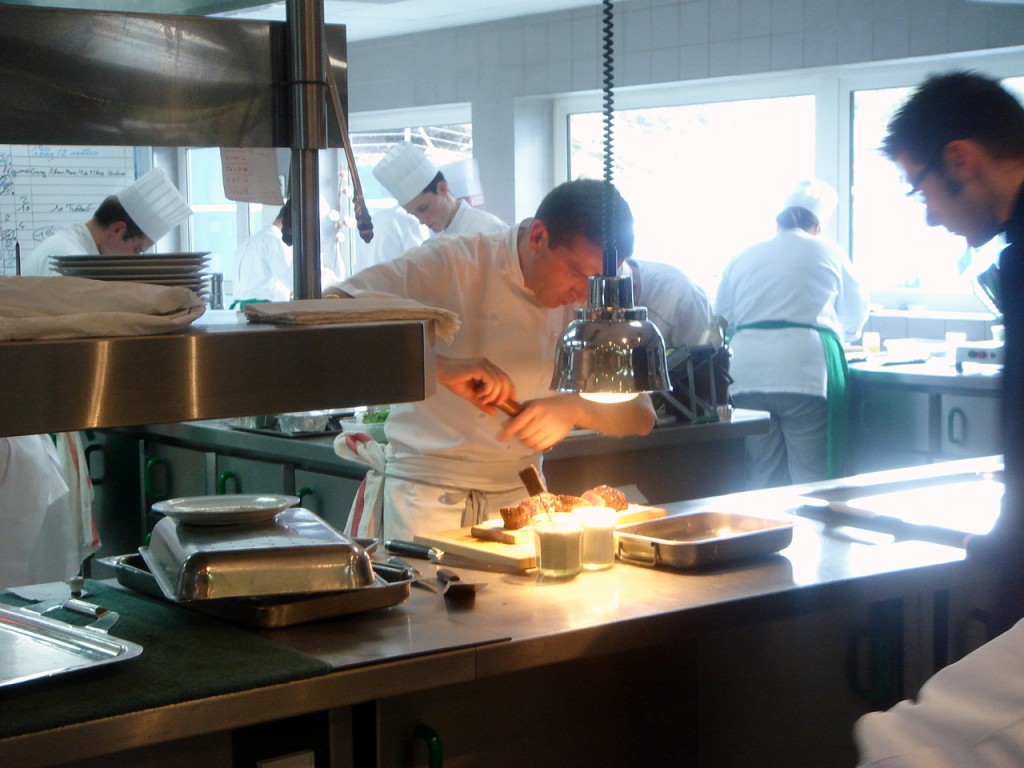
Sébastien Bras
Given its hilltop location, it is no surprise that as you enter the restaurant and step into the lounge you are immediately presented with spectacular views of the surrounding green valleys. This is a spot to linger and enjoy the sense of anticipation of the forthcoming meal. The restaurant is a statement in modernity and minimalism. Housed in a grey concrete structure, it verges on sterility. But its design was engineered for a specific purpose – to provide a calm, unemotional environment such that it does not distract diners from the food. As we sipped champagne (Billecart-Salmon Rose (€27)) in the lounge and perused the menu, an amuse bouche of lightly cooked creamed egg with chive oil and served in its own shell was presented to us. It came with bread sticks cooked with three different types of cheeses for dipping. This was pleasant but unremarkable, and from some of the research I had done on Bras, is an amuse bouche that does not seem to have changed significantly from those served in years past.
At this point, I have to confess that I felt a twinge of disappointment on discovering that there was no chicken on the menu. The blogs, Chuckeats and Opinionated about Dining, had claimed it to be amazing and I had been hoping to try it. Furthermore, the à la carte options were very limited. Divided into four sections which consisted of vegetable starters, hot and cold starters, fish mains and meat mains, the menu was limited to three choices for each. Seeing as we were in the landlocked region of Auvergne, I thought I would choose meat rather fish. But that left us with only 3 options: a lamb and 2 different types of beef. In the end we settled for the tasting menu (8 courses for €179), but one could not help but feel that the menu’s limitations are designed to steer people towards choosing the tasting menu, which perhaps helps the kitchen to churn out the food as if on a production line. The alternative choices were a vegetable tasting menu (€132) and a smaller 6 course tasting menu (€111). Whilst the latter seemed like a good alternative to the pricier 8 course tasting, it did not include gargouillou as one of its courses.
Before we were taken to our table, we visited the kitchen. It is state of the art, and temperature controlled – so it is cool, rather than hot. Both Michel and Sébastien were busy working away, although they took time to greet us, and were lovely, warm and welcoming.
We started with canapés served in spoons: lentils, a seafood mouse and lamb with mustard and sesame which were pleasant. This was then followed by the fabled gargouillou. The presentation did not match up to the beauty of some of the pictures I had seen of the dish in professional publications. But despite this, it truly was a remarkable dish. With some 50 different types of vegetables, herbs, flowers and vegetable purees – some picked wild, some grown in Bras’ garden – the dish was outstanding for the purity and clarity of flavour of each of the ingredients. All the vegetables are cooked in separate pots of water and it is therefore quite remarkable that when presented, all the vegetables maintain the same serving temperature. Also served with a small slice of Serrano ham and lait de poule à la noisette, a slightly eggy, hazelnut chicken broth, the balance of flavours wowed and ensured that you slowly savoured every delectable bite.

Canapés

Gargouillou
For all my initial hesitations about having fish, the next course of seabass was stunning. Perfectly cooked, and verging on slightly raw, it delivered a velvety smooth texture on the palate. Served with a bread and olive sauce, it was accompanied by wild rocket, and a cake made from thinly sliced potato, the slicing of which provided layer upon layer of texture and flavour.
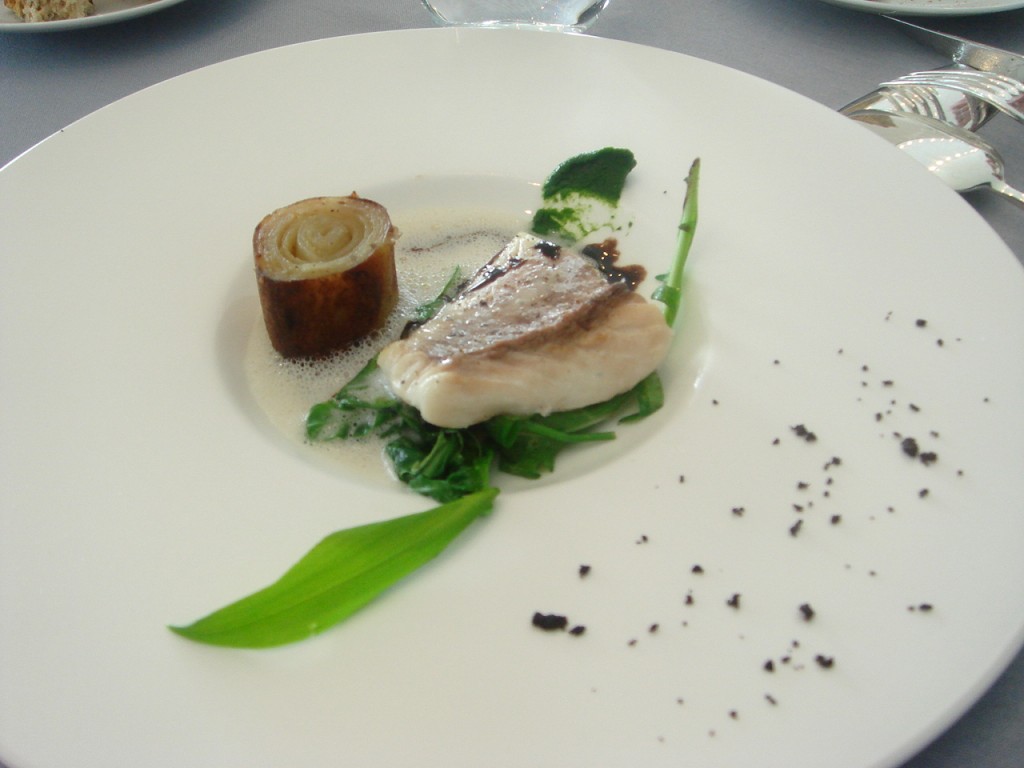
Seabass with bread & olive sauce
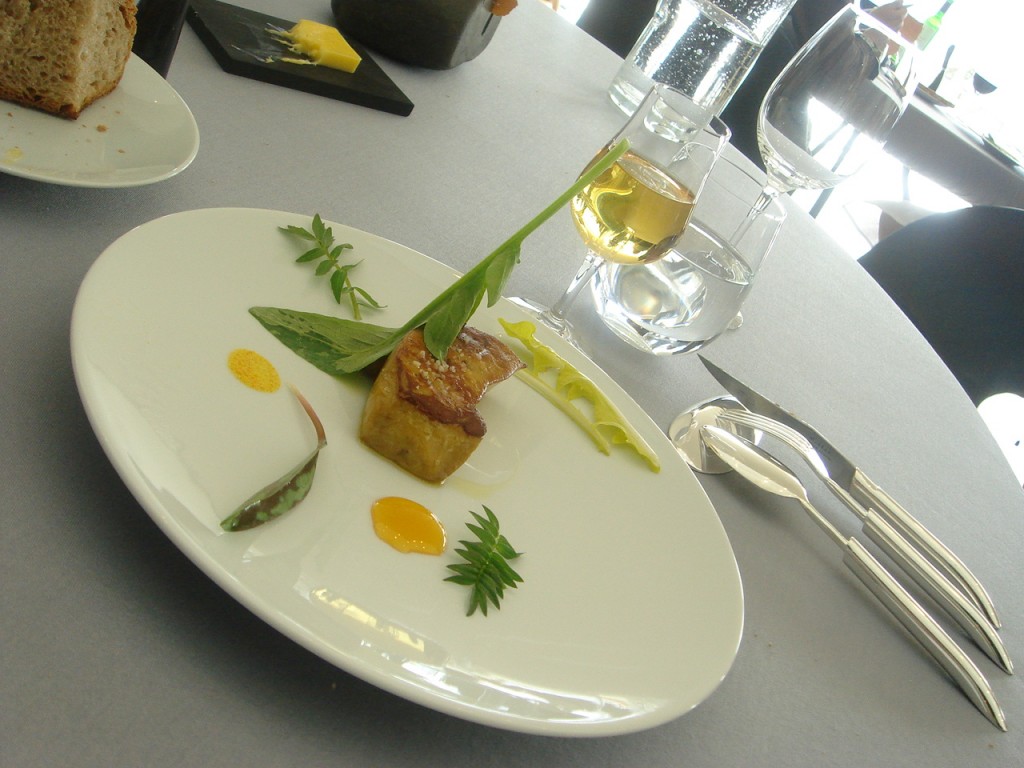
Foie gras de canard poêle
Le foie gras de canard poêle from Vendée was firm and meaty. Crisped to a golden orangey brown colour, it cut like soft butter and was without any hint of mushiness. It was served with an orange sauce, finely grated orange skin and a rich orange chutney. The latter was an outstanding demonstration in balancing sweet against tart, and together with the sauce, it served to boost the flavour of the beautiful piece of foie gras.
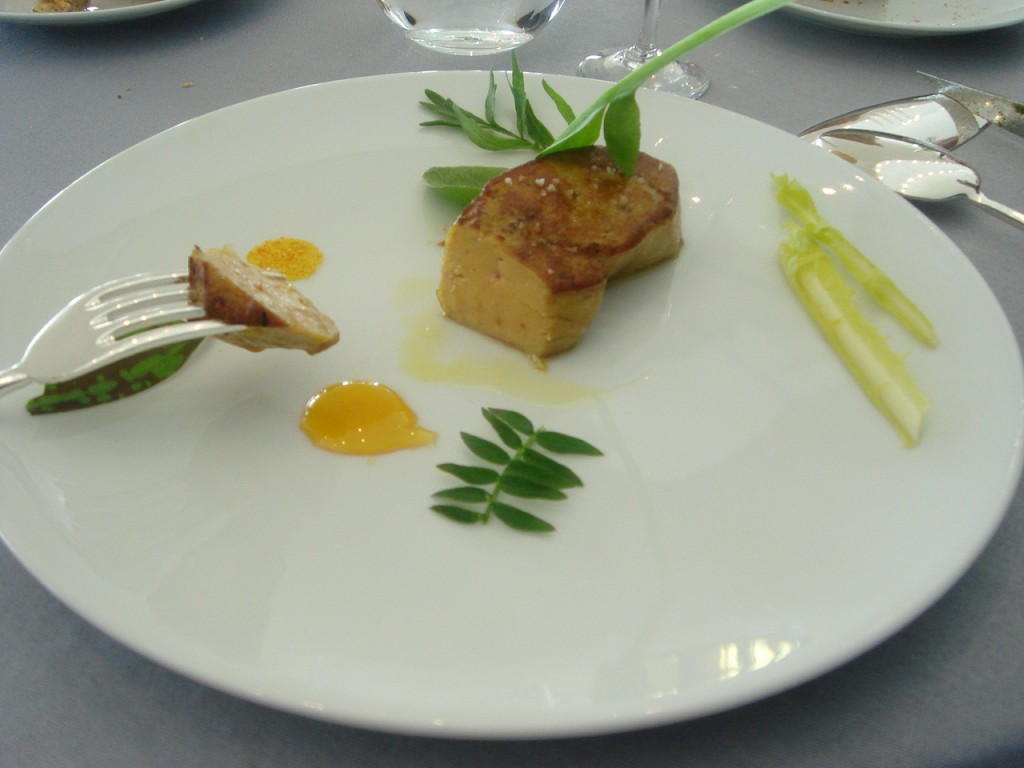
Foie gras de canard poêle
Next was l’endive farci au gras, an endive stuffed with foie gras, finely chopped egg, herbs, vegetables, and cooked in butter. The dish was pleasant, but unexciting, and was an unusual choice to follow the foie gras, and to precede the meat main course. It did little to enhance the tasting menu, and the only purpose that I could see was to fill out the menu. In retrospect, I would have preferred that this dish be left off the tasting menu, with a corresponding decrease in its price.

Stuffed endive
A rack of lamb from Aveyron was next. Served with buckwheat in a light broth of lamb jus, coco and coriander, the lamb was mouth-wateringly tender and succulent, although it did not have an intensely gamey rich flavour that some lamb lovers might otherwise prefer. The dish was inspiring for its delicacy and poise, rather than for any great meatiness.
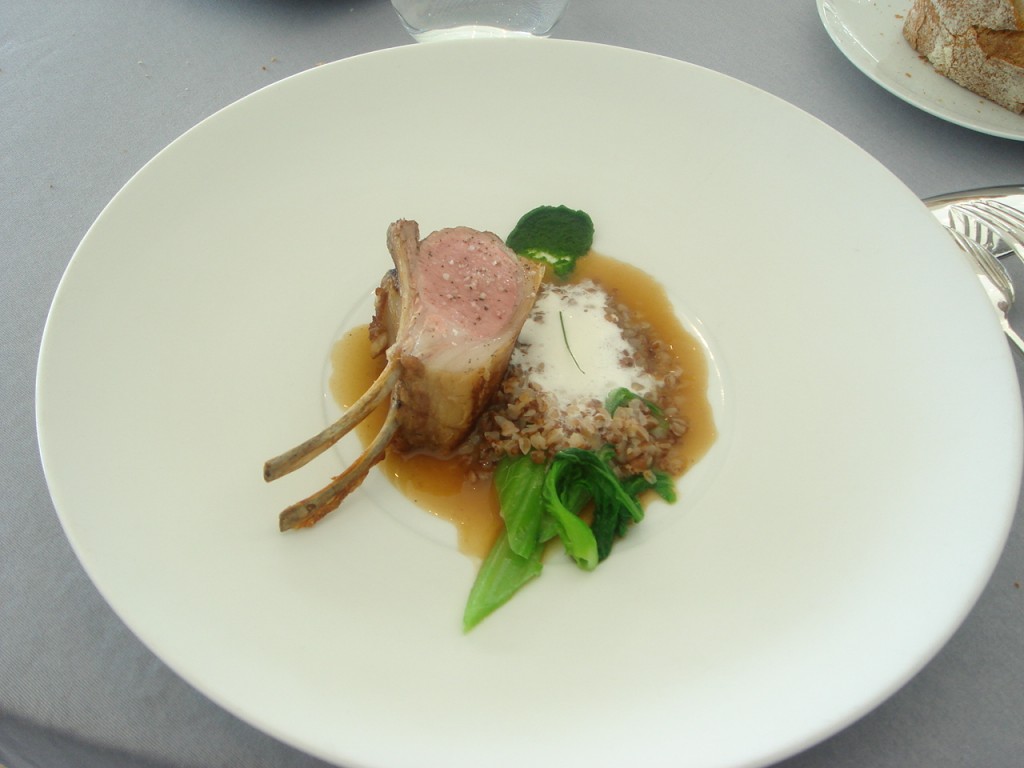
Rack of lamb from Aveyron
Aligot, a cheesy, garlicky mashed potato, was surprisingly served to us when we had virtually finished eating the lamb. When we questioned the timing of this, we were advised that aligot is traditionally served after the main course. Given the research I had done, and the fact that the table next to us was served their aligot at the same time as their mains, I suspect this was in fact an error in timing on the part of the restaurant. The dish itself is quite stringy. There was no discernible taste of garlic, and it tasted more of stretchy cheese than potato. The serving of the aligot is quite theatrical as the waiter twirls it around two forks before presenting it on the plate.
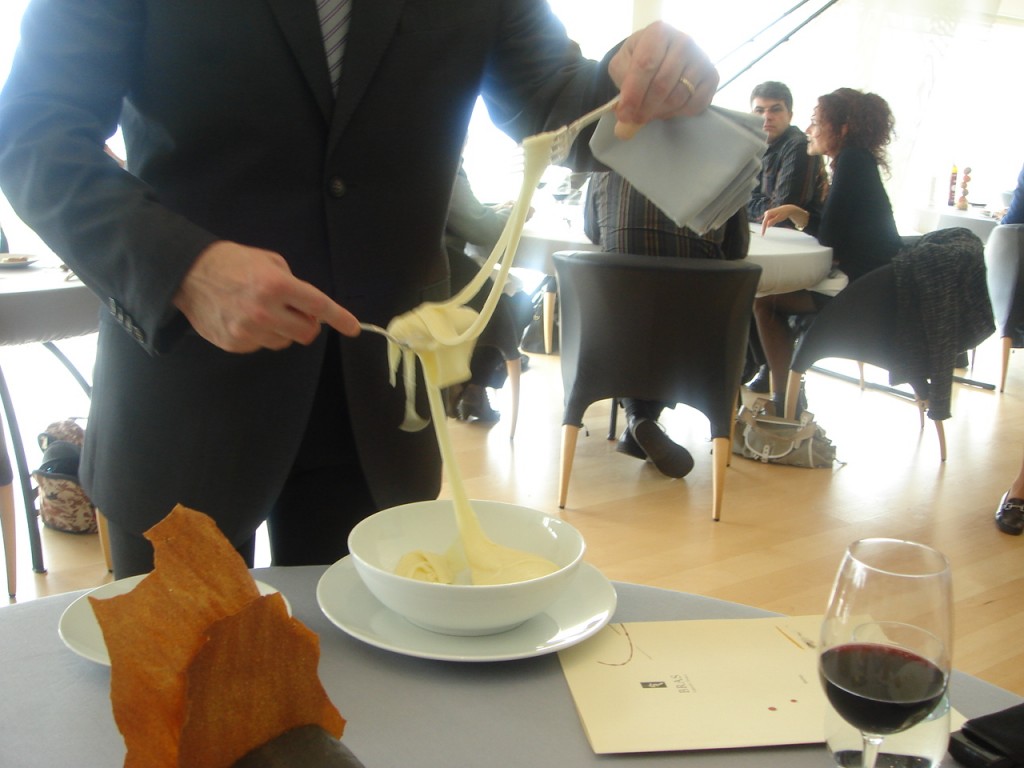
Serving the aligot
Cheeses were from Aveyron and we sampled a full range, some 12 varieties between the 2 of us: from the soft to the hard to the blue cheeses. All the cheeses were exquisite and perfectly ripened. These were truly a high point.

The cheese trolley
To dessert, and first up was an adaptation of his one and only chocolate coolant, une interpretation du coolant, original de 81. Devised by Michel Bras in 1981, he applied for a patent for this creation of a chocolate cake with a warm runny centre, which has subsequently been copied worldwide, and is now more commonly known as a chocolate fondant. Served with a banana sorbet and caramel sauce, the combination was divine, the sweetness of the caramel merging with the richness of banana and chocolate.
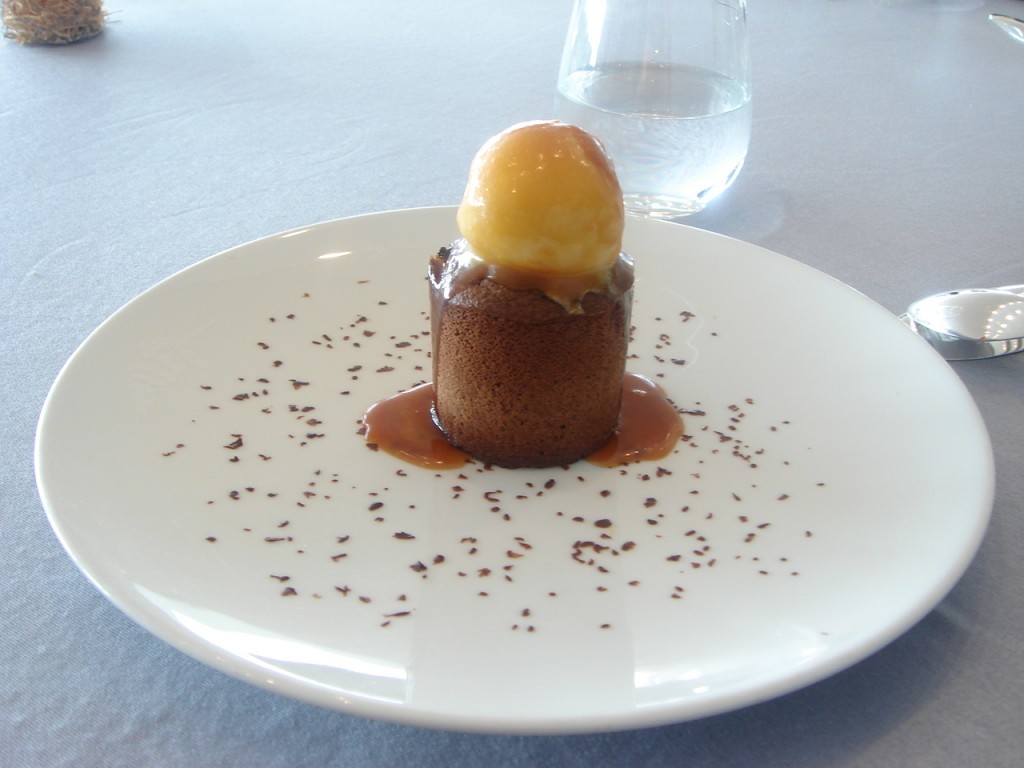
Chocolate coolant with a banana sorbet & caramel sauce
A second dessert of a potato cream, sandwiched in between wafer thin potato gaufrettes, tasted odd. The accompanying rice jelly was also bland. There were also some pear and aniseed, and honey and lemon ‘ices’ which were almost too cold to eat.
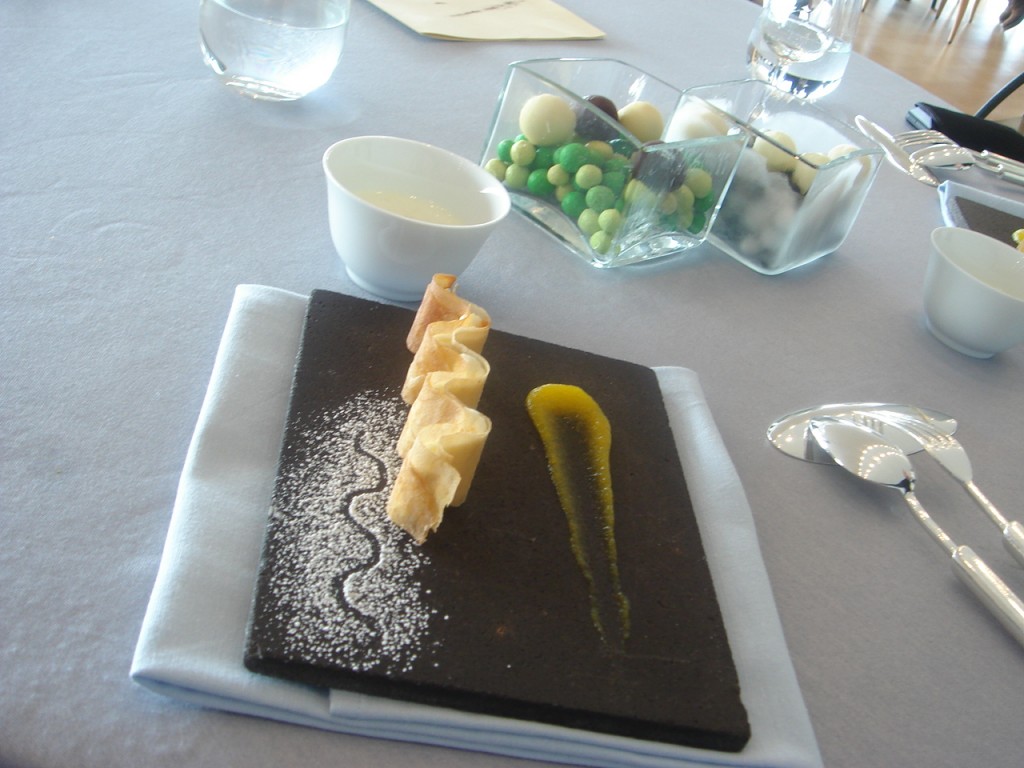
Dessert of potato cream
The petits fours served with coffee included shot size glasses of liqueurs (one coffee and one banana) topped with milk. This was delicious, although the chocolate crunch was quite ordinary. There were also some caramelised violets which tantalisingly tasted like little crunchy bites of sweet flowers.
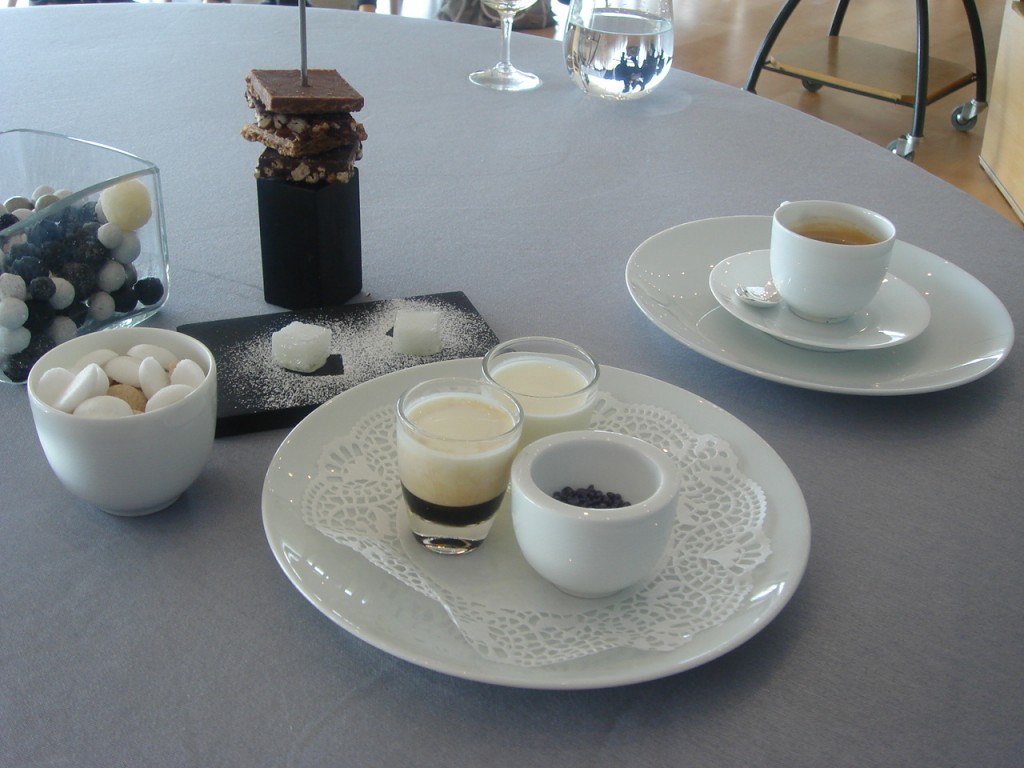
Petits fours
Breads included country, cereal and corn, of which the latter was particularly flavoursome. Beautifully baked, the centres were soft and the crusts hard and crunchy. Butter was from Alsace, and lightly salted. Served at a perfect room temperature, it was soft for spreading and beautifully creamy.
For wines, we requested the Sommerlier’s choice for each dish, which on the whole were excellent. A Bergerac sec 2007 matched our fish course superbly, and a Jurançon Uroulat 2005 went well with the foie gras. However, we were given the same red wine of Côtes du Marmandais, Chante Coucou 2004 for both the endive and the lamb courses; and felt that more effort could perhaps have been made by the Sommelier to provide us with an additional wine selection. Wines over seven courses, including an extra glass of the Jurançon Uroulat, came to €110 (total 8 glasses).
Service on the whole was fine, despite what seemed to be a mistake with the timing of the aligot. Also, there was no folding of my napkin or a replacement with a fresh one when I ducked off to the bathroom, something par for the course at a restaurant of this level, especially at these prices. But it was pleasing to find the waitress offering us house water when we first sat down, instead of trying to push the bottled variety on us.
The cooking at Bras is precise, exacting and technically executed. Not all dishes delivered coherent flavours, but when they did, the experience tasted like perfection on a plate. But the most outstanding aspect of dining at Bras is the quality of the ingredients, which is of the highest order, and the purity of flavour that is drawn from each of them. The focus here is delivering a clear and clean palate, rather than the intense, rich sauces typical in tradition French cooking. Restaurant Bras is an experience to savour. I might have not liked all the dishes, and I might have had to endure a repeat visit to Rodez, but for years to come, this will rate as an occasion to remember.
[xrrgroup]
Summary information
Food rating: [xrr rating=4.5/5]
Service rating: [xrr rating=3.5/5]
Prices – Price of the set menus are listed above. From the à la carte menu, starters are between €35 and €55. Mains are between €45 and €70. Excludes drinks but includes service.
[/xrrgroup]
Basically very expensive when you take into account flights, accommodation and car hire.
Michel & Sébastien Bras at:
Route de L’Aubrac – 12210
Laguiole, France
Tel: +33 (0)5 65 51 18 20
Web: http://www.michel-bras.com/
Note:
If you are in Laguiole, and looking for somewhere more low key to eat, for instance a place for lunch the day after a big meal at Bras, you can also try Restaurant L’Aubrac, which is on the main street of Laguiole (17 Allee de L’Amicale 12210 Laguiole). Set menus range in price from €10.50 to €27. A decent rump steak cost us €14 and came with an enormous side of our choice.
April 29th, 2009 at 3:42 pm
The seabass looks just awesome! Great review!
April 29th, 2009 at 3:50 pm
Thanks for the wonderful review. I ate there 3 years ago but it is becoming more and more clear to me that Michel Bras is the patron saint of a newer wave of American cooking that emphasizes purity of flavor.
April 29th, 2009 at 3:55 pm
THANK YOU FOR SHARING THIS, GIRL !
THE THREE STAR RESTAURANTS ARE A TREAT TO TRY, ESPECIALLY BECAUSE THERE ARE SO FEW OF THEM !
I’d have loved to try their vegetarian tasting menu and compared it to Gordon Ramsay RHR, Fat Duck and Waterside Inn…
April 29th, 2009 at 7:16 pm
It is very interesting to know about the restaurants in other parts of the world. Pheraps one day i go there.
April 29th, 2009 at 11:10 pm
Hi Natasha, thanks! The seabass was really delicious!
Chuckeats, thanks for visiting my blog. I really enjoyed reading your write up too. I would have liked to have visited Bras years ago so that I could have compared it to how it is now.
Loving Annie, Next time you come to London, maybe a trip to France and Bras is also on the cards?
Portuguese Flavours, if you get the chance to go, I really recommend it.
April 30th, 2009 at 11:21 am
This sounds like a truly amazing experience and I have learned something new as I did not realise the fondant was invented here – your return trip seems well worth while!
April 30th, 2009 at 8:07 pm
Great write up, and lovely photos too.
May 10th, 2009 at 2:28 pm
Very nice review, seemed like it was worth the trip! I am still waiting form my first visit there but it’ll come some day.
Just a few things: farci au gras doesn’t necessarily involve foie gras, rather it will have lard and other greasy pork cuts in it.
Strange to see that the aligot had garlic in it. As far as I know, it usually only consists of Potatoes, young tomme de Laguiole, cream and butter. But well, they might have changed the recipe.
May 13th, 2009 at 11:49 pm
Dear Felix,
Thank you for commenting on my blog. I always want to learn as much about food as I can and I appreciate comments from people more knowledgeable abou food then myself.
You are absolutely right. When I had farci au gras dish, I was convinced I heard Véronique Bras, wife of Sebastien, say that the dish contained foie gras. I double checked this with my dining companion. To this extent, that is why I wrote that it contained foie gras. I have checked with the restaurant, and they have told me it actually contains duck fat. This is my mistake.
I also checked with the restaurant about the aligot. Yes, you are correct, it contains no garlic. I must confess, I have never made aligot. I made this comment because my research through various food blogs and websites led me to believe there is garlic in it. Just as well I wrote that I couldn’t taste any.
Once again, thank you for pointing this out. I really appreciate it.
June 26th, 2013 at 8:42 am
[…] Locul 69 – Bras, Laguiole, Franta. Restaurant de hotel de top. Aici: ciosvartica de miel (sursa). […]